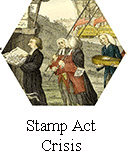 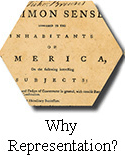 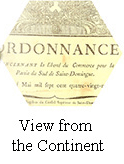 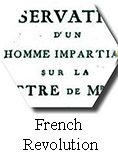 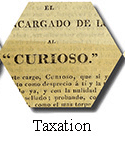 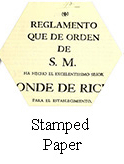 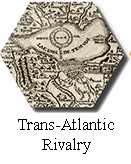 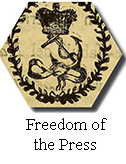 |
| |
FREEDOM OF THE PRESS |
|
|
42. Juan Pablo Vizcardo y Guzmán, 1748-1798. Lettre aux Espagnols-Américains. A Philadelphie. [i.e. London] : [s.n.], MDCCXCXIX.
Vizcardo y Guzmán's Letter to the Spanish Americans, penned in 1791 but not published until after his death in 1798, is a plea for Spanish American independence, frequently citing the American Revolution and the devastation caused by the Tupac Amaru rebellion. |
|
|
43. Andrés Level de Goda, 1777-1851 or 1852. El tapaboca. Impreso en Puerto Rico: [s.n.], Año de 1812.
Pamphleteering of the sort seen in the United States and elsewhere did not fully emerge in Spanish America until 1812 and the promulgation of the Constitution of Cádiz. Even then, it took on different forms, as in this unique imprint from Puerto Rico. A multi-part work, concerning the wars of independence in South America, it opens with a letter to Andrés Level de Goda, signed: Leandro de Uldesage. This is followed by a short poem (by one José Maria Guerra de la Vega) and then a more lengthy poem. Next are 70 separate annotations about the poetry, and the work ends with a letter to Uldesage which is signed: Level. |
|
| |
44. José Joaquín Fernández de Lizardi, 1776-1827. Pensador mexicano. [Mexico]: Imprenta de doña María Fernández Jauregui, año de 1812.
The periodical press in Spanish America began in 1722, and by the second half of the eighteenth century literary and scientific periodicals were circulating Enlightenment ideas, though shying away from politics. With the declaration of press freedom, and the on-going wars for independence, this changed. Among the most famous of Spanish American writers was José Joaquín Fernández de Lizardi and his periodical Pensador mexicano. He has been called the Mexican equivalent of Thomas Paine. |
|
|
45. El Peruano por don Guillermo del Rio y Compañia. [Lima]: Imprenta de los Huerfanos, [1811-1812].
In South America, even prior to the full declaration of freedom of the press, El Peruano focused on debates transpiring in the Córtes of Cádiz, particularly issues related to the Americas; extinction of indigenous tribute; and equality between Spaniards and creoles in access to political appointments. While primarily with a Lima readership, issues circulated as far away as Buenos Aires and Santiago de Chile. |
|
|
46. Grito del Sud. Buenos-Ayres: Imprenta de Niños Expositos, 1812-1813.
The short-lived Grito del Sud was founded by members of the Sociedad Patriotica y Literaria de Buenos Aires, three years following the call for independence. |
|
|
47. Thomas Paine, 1737-1809. Reflecciones politicas escritas bajo el titulo de Instinto comun / por el ciudadano Tomas Paine, y traducidas abreviadamente por Anselmo Nateiu. indigena del Peru. Lima: En la Imprenta de Rio., año de 1821.
Vizcardo y Guzmán's Letter to the Spanish Americans, copies of the U. S. Declaration of Independence, and Spanish translations of Paine's Common Sense circulated in Spanish America, though clandestinely. This edition of Paine was likely published only after Peru formally signed its declaration of Independence in July of 1821. |
|
| |
This symbol indicates the entire scanned book,
may be read on the John Carter Brown Library's Internet Archive collection. >>> |
|
| |
Exhibition prepared by dennis landis, kim nusco, neil safier, and kenneth c. ward.
on view in the reading room from october 2015 to january 2016. |
|